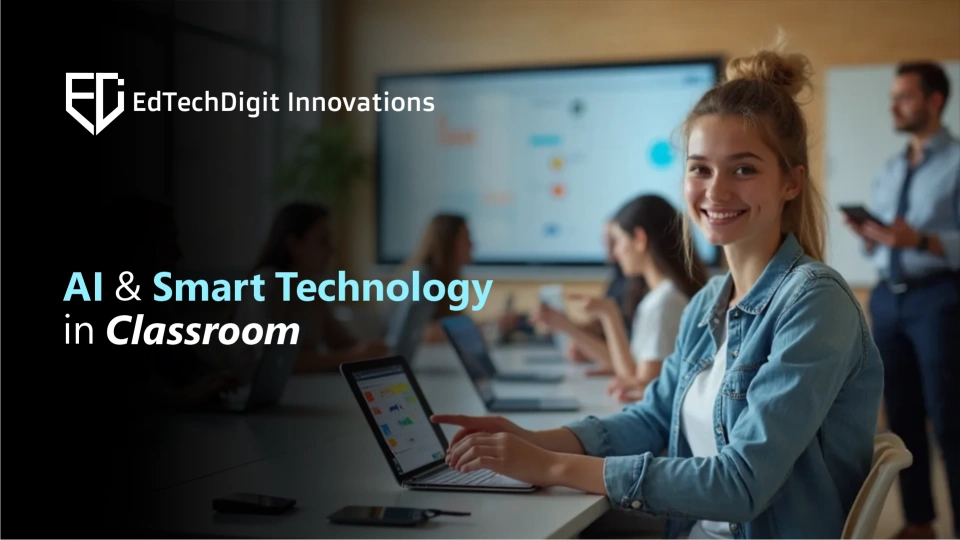The world of education is changing faster than ever before, and 2025 is proving to be a critical year, as technology continues to disrupt classrooms. The EdTech market is shifting fast; it is estimated by HolonIQ to grow to $404 billion between now and 2025. AI in school education changes the way students learn and teachers teach. Not only are these advances making education more engaging and interactive, but learning has never been so personalized and accessible.
The Rise of Smart Classrooms
Smart classrooms incorporate advanced technology to turn traditional classrooms into interactive and collaborative learning environments. Here are some common features of smart classroom technology:
- Interactive Whiteboards, like all-in-one touchscreens, can easily replace blackboards and offer a more robust platform for a lesson, which includes accessing videos and other multimedia.
- Cloud-connected devices such as tablets and laptops can allow students to sign in and access materials anywhere and focus on collaboration compared to traditional computers.
- AI Powered Learning Platforms track progress in real-time and tailor lessons to individual students at their level.
Overall, these AI learning tools facilitate active participation and support learning for a range of students and needs.
AI Is Powering Personalized Learning
Artificial Intelligence is fostering personalized learning in 2025 by assisting both students and teachers in many ways:
Performance tracking: AI can rapidly evaluate a student's answers to identify strengths and weaknesses and provide timely personalized feedback.
Custom learning paths: Lessons are adjusted to suit each student's pace and style of learning so that no student has to wait; for instance, students needing additional math practice would be given extra math practice if they needed it.
Instant feedback: AI instantly grades work so that students can learn from their mistakes straight away, keeping them on a path of continual improvement without waiting for delayed feedback.
Making Learning Engaging with Immersive Technologies
Engagement is a major issue presented with traditional classrooms. Students can find lessons to be boring or irrelevant to their lives. Smart classrooms find ways to engage students with immersive technologies like Virtual Reality (VR) and Augmented Reality (AR):
Virtual Field Trips: Instead of reading about the pyramids, students can visit ancient Egypt using VR, with the freedom to walk around the pyramids and temples in a 360-degree way!
Virtual Labs: Science experiments that are too dangerous, expensive, or not achievable in the real world can be safely undertaken with VR and AR, allowing for hands-on practice without the physical limitations you would have in reality.
Interactive 3D Models: Complex topics like human anatomy or mechanical engineering can be simplified with 3D models that students can manipulate in real-time and spin around.
Streamlining Administrative Tasks with AI
In ways beyond teaching and learning, AI is impacting the administration of schools, giving educators more time to spend with students:
Automated Grading: AI is capable of grading multiple-choice and even some written assignments, saving teachers time.
Attendance with Facial Recognition: Smart classrooms can use facial recognition software for attendance that eliminates the chance for mistakes or time spent on roll call.
Using Data in Decision Making: AI can combine data based on student performance, attendance, and behavior, allowing administrators to analyze the data to improve how schools are run and how to teach.
As schools streamline these redundant functions, they improve efficiency while allowing teachers to connect meaningfully with students.
Addressing Challenges and Ethical Considerations
While there are many advantages, there are challenges to combining AI and smart technology into classrooms:
Data Privacy: Collecting and reviewing student data raises confidentiality and data security issues. Schools need to provide protections for sensitive data.
Digital Divide: Students do not have the same access to devices or solid internet connections. Adoption of technologies, if not managed, may increase inequity in education.
AI Bias: AI algorithms may sometimes promote bias that exists in the training data, potentially impacting some students' experience negatively. It is incumbent on schools to review and modify their functions so that equity is assured.
Institutions, governments, and technology developers must collaborate to establish ethical frameworks and policies that will address these issues and maximize the positives.
The Future of Education with Smart Technology
While looking into the future, the merging of AI and smart technologies will lead to even further developments:
AI Libraries: Libraries like this could be built on AI, recommending the next best book and resources for the individual student’s interests and curriculum.
Robotics and Coding Labs: Students will be introduced to robotics and coding with AI tutors, making them tech-ready for future jobs in the technology space.
Sustainable Digital Campuses: Smarter buildings that optimize energy use and promote sustainable behavior within the school community to make educational environments smarter and greener.
Conclusion
The changing nature of classrooms with smart technologies and AI is not a passing trend; it's a fundamental shift in education. Personalized learning, immersive experiences for all students, and streamlined administrative processes are now possible to support every student in reaching their goals.
For these impacts to be realized, technologies need to evolve with aspirations for thoughtful, equitable, and ethical use. With collaborative efforts from educators, technologists, and policymakers, classrooms of the future will be vibrantly representative of technology and human ingenuity to realize the potential of every student.

